Effect of β-Cyclodextrin on the Aggregation Behavior of Sodium Deoxycholate and Sodium Cholate in Aqueous Solution
Abstract
1. Introduction
2. Results
2.1. Interaction of β-Cyclodextrin and Bile Salts in Aqueous Solution Without Additives
2.2. Interaction of β-Cyclodextrin and Bile Salts in Aqueous Solution with Sodium Chloride and Aqueous Solution with Cesium Chloride
3. Discussion
4. Materials and Methods
4.1. Materials
4.2. Preparation of Stock and Working Solutions
4.3. Tensiometric Measurements
4.4. Conductometric Measurements
4.5. Spectrofluorometric Measurements
5. Conclusions
Supplementary Materials
Author Contributions
Funding
Institutional Review Board Statement
Informed Consent Statement
Data Availability Statement
Acknowledgments
Conflicts of Interest
Abbreviations
| βCD | beta cyclodextrin |
| NaDC | sodium deoxycholate |
| NaC | sodium cholate |
| CMC | critical micellar concentration |
References
- Hao, L.-S.; Wang, H.-X.; Wang, Y.-S.; Meng, Y.-Q.; Nan, Y.-Q. Inclusion complexation of surfactant with β-cyclodextrin and its effect on the mixed micellization of cationic/anionic surfactants. Colloids Surf. A Physicochem. Eng. Asp. 2023, 668, 131437. [Google Scholar] [CrossRef]
- Borregaard Eriksen, J.B.; Christensen, S.B.; Bauer-Brandl, A.; Brandl, M. Dissolution/permeation of albendazole in the presence of cyclodextrin and bile salts: A mechanistic in vitro study into factors governing oral bioavailability. J. Pharm. Sci. 2022, 111, 1667–1673. [Google Scholar] [CrossRef]
- Junquera, E.; Tardajos, G.; Aicart, E. Effect of the presence of β-cyclodextrin on the micellization process of sodium dodecyl sulfate or sodium perfluorooctanoate in water. Langmuir 1993, 9, 1213–1219. [Google Scholar] [CrossRef]
- Dhiman, P.; Bhatia, M. Pharmaceutical applications of cyclodextrins and their derivatives. J. Incl. Phenom. Macrocycl. Chem. 2020, 98, 171–186. [Google Scholar] [CrossRef]
- Kalepu, S.; Nekkanti, V. Insoluble drug delivery strategies: Review of recent advances and business prospects. Acta Pharm. Sin. B 2015, 5, 442–453. [Google Scholar] [CrossRef] [PubMed]
- Benkő, B.-M.; Tóth, G.; Moldvai, D.; Kádár, S.Z.; Szabó, E.; Szabó, Z.-I.; Kraszni, M.; Szente, L.; Fiser, B.; Sebestyén, A.; et al. Cyclodextrin encapsulation enabling the anticancer repositioning of disulfiram: Preparation, analytical and in vitro biological characterization of the inclusion complexes. Int. J. Pharm. 2024, 657, 124187. [Google Scholar] [CrossRef]
- Puskás, I.; Szente, L.; Szőcs, L.; Fenyvesi, E. Recent list of cyclodextrin-containing drug products. Period. Polytech. Chem. Eng. 2023, 67, 11–17. [Google Scholar] [CrossRef]
- Azum, N.; Moteb Alotaibi, M.; Ali, M.; Rub, M.A.; Marwani, H.M.; Alamry, K.A.; Asiri, A.M. Investigation of an anaesthetic drug (tetracaine hydrochloride) in the presence of ionic fluid and surfactant: Mixed micellization & spectroscopic studies. J. Mol. Liq. 2023, 370, 121057. [Google Scholar]
- Rub, M.A.; Azum, N.; Khan, F.; Asiri, A.M. Aggregation of sodium salt of ibuprofen and sodium taurocholate mixture in different media: A tensiometry and fluorometry study. J. Chem. Thermodyn. 2018, 121, 199–210. [Google Scholar] [CrossRef]
- Rub, M.A.; Azum, N.; Asiri, A.M.; Alfaifi, S.Y.M.; Alharthi, S.S. Interaction between antidepressant drug and anionic surfactant in low concentration range in aqueous/salt/urea solution: A conductometric and fluorometric study. J. Mol. Liq. 2017, 227, 1–14. [Google Scholar] [CrossRef]
- Bagheri, A. Comparison of the interaction between propranolol hydrochloride (PPL) with anionic surfactant and cationic surface active ionic liquid in micellar phase. Colloids Surf. A Physicochem. Eng. Asp. 2021, 615, 126183. [Google Scholar] [CrossRef]
- Poša, M.; Škorić, D.; Pilipović, A. Binary mixture (1:1) of Triton X100 and propranolol hydrochloride in an aqueous solution of NaCl: Whether mixed micelles are formed, possible clarification in 1H DOSY NMR experiment. J. Mol. Liq. 2023, 369, 120870. [Google Scholar] [CrossRef]
- Kumar, D.; Farakaš Agatić, Z.; Popović, K.; Poša, M. Binary mixed micelles of hexadecyltrimethylammonium bromide-sodium deoxycholate and dodecyltrimethylammonium bromide-sodium deoxycholate: Thermodynamic stabilization and mixed micelle’s solubilization capacity of daidzein (isoflavonoid). Ind. Eng. Chem. Res. 2024, 63, 3336–3348. [Google Scholar] [CrossRef]
- Ghasemi, A.; Bagheri, A. Effects of alkyl chain length on synergetic interaction and micelle formation between a homologous series of n-alkyltrimethylammonium bromides and amphiphilic drug propranolol hydrochloride. J. Mol. Liq. 2020, 298, 111948. [Google Scholar] [CrossRef]
- Pletnev, M.Y. Chemistry of surfactants. In Studies in Interface Science; Fainerman, V.B., Möbius, D., Miller, R., Eds.; Elsevier: Amsterdam, The Netherlands, 2001; Volume 13, pp. 1–97. [Google Scholar]
- Natalini, B.; Sardella, R.; Gioiello, A.; Ianni, F.; Di Michele, A.; Marinozzi, M. Determination of bile salt critical micellization concentration on the road to drug discovery. J. Pharm. Biomed. Anal. 2014, 87, 62–81. [Google Scholar] [CrossRef]
- Poša, M. Self-association of the anion of 7-oxodeoxycholic acid (bile salt): How the secondary micelles are formed. Int. J. Mol. Sci. 2023, 24, 11853. [Google Scholar] [CrossRef]
- Pártai, L.B.; Jedlovszky, P.; Sega, M. Molecular aggregates in aqueous solutions of bile acid salts. Molecular dynamics simulation study. J. Phys. Chem. B 2007, 111, 9886–9896. [Google Scholar] [CrossRef]
- Poša, M.; Pilipović, A.; Bjedov, S.; Obradović, S.; Tepavčević, V.; Sakač, M. Parameters of micellization and hydrophobicity of sodium salts of 7-buthyl (butylidene) and 7-octyl (octylidene) derivatives of the cholic and the deoxycholic acid in a water solution: Pattern recognition—Linear hydrophobic congeneric groups. J. Mol. Liq. 2016, 224, 9–18. [Google Scholar] [CrossRef]
- Roda, A.; Hofmann, A.F.; Mysels, K.J. The influence of bile salt structure on self-association in aqueous solutions. J. Biol. Chem. 1983, 258, 6362–6370. [Google Scholar] [CrossRef]
- Zana, R. Critical micellization concentration of surfactants in aqueous solution and free energy of micellization. Langmuir 1996, 12, 1208–1211. [Google Scholar] [CrossRef]
- Rusanov, A.I. The wonderful world of micelles. Colloid J. 2014, 76, 121–126. [Google Scholar] [CrossRef]
- Cabrer, P.R.; Alvarez-Parrilla, E.; Meijide, F.; Seijas, J.A.; Núñez, E.R.; Tato, J.V. Complexation of sodium cholate and sodium deoxycholate by β-cyclodextrin and derivatives. Langmuir 1999, 15, 5489–5495. [Google Scholar] [CrossRef]
- Fajalia, A.I.; Tsianou, M. Self-assembly control via molecular recognition: Effect of cyclodextrins on surfactant micelle structure and interactions determined by SANS. Colloids Surf. A Physicochem. Eng. Asp. 2015, 480, 91–104. [Google Scholar] [CrossRef]
- Loftsson, T.; Brewster, M.E. Pharmaceutical applications of cyclodextrins: Basic science and product development. J. Pharm. Pharmacol. 2010, 62, 1607–1621. [Google Scholar] [CrossRef] [PubMed]
- Li, J.; Loh, X.J. Cyclodextrin-based supramolecular architectures: Syntheses, structures, and applications for drug and gene delivery. Adv. Drug Deliv. Rev. 2008, 60, 1000–1017. [Google Scholar] [CrossRef]
- Kurkov, S.V.; Loftsson, T. Cyclodextrins. Int. J. Pharm. 2013, 453, 167–180. [Google Scholar] [CrossRef]
- Poša, M.; Farkaš Agatić, Z.; Popović, K. Influence of cations of the first group of the Periodic Table of Elements on the thermodynamic stabilization of cholic and deoxycholic acid anion micelles. J. Mol. Liq. 2019, 296, 111840. [Google Scholar] [CrossRef]
- Small, D.M. The physical chemistry of cholanic acids. In The Bile Acids: Chemistry, Physiology and Metabolism; Nair, P.P., Kritchevsky, D., Eds.; Plenum Press: New York, NY, USA, 1971; Volume 3, pp. 249–332. [Google Scholar]
- Poša, M. Parallel (competitive) reactions of micelle formation and cyclodextrin–surfactant inclusion complex formation in aqueous solution: A consequence of the Gibbs-Duhem equation—Invariance of the mass action law and the possibility of determining the equilibrium constant of the inclusion complex. J. Mol. Liq. 2024, 415, 126409. [Google Scholar]
- Cabrer, P.R.; Álvarez-Parrilla, E.; Al-Soufi, W.; Meijide, F.; Núñez, E.R.; Tato, J.V. Complexation of bile salts by natural cyclodextrins. Supramol. Chem. 2003, 15, 33–43. [Google Scholar] [CrossRef]
- Tan, Z.J.; Zhu, X.X.; Brown, G.R. Formation of inclusion complexes of cyclodextrins with bile salt anions as determined by NMR titration studies. Langmuir 1994, 10, 1034–1039. [Google Scholar] [CrossRef]
- Jójárt, B.; Poša, M.; Fiser, B.; Szőri, M.; Farkaš, Z.; Viskolcz, B. Mixed micelles of sodium cholate and sodium dodecylsulphate 1:1 binary mixture at different temperatures—Experimental and theoretical investigations. PLoS ONE 2014, 9, e102114. [Google Scholar] [CrossRef] [PubMed]
- Kim, J.H.; Domach, M.M.; Tilton, R.D. Pyrene micropartitioning and solubilization by sodium dodecyl sulfate complexes with poly(ethylene glycol). J. Phys. Chem. B 1999, 103, 10582–10588. [Google Scholar] [CrossRef]
- Natalini, B.; Sardella, R.; Camaioni, E.; Gioiello, A.; Pellicciari, R. Correlation between CMC and chromatographic index: Simple and effective evaluation of the hydrophobic/hydrophilic balance of bile acids. Anal. Bioanal. Chem. 2007, 388, 1681–1688. [Google Scholar] [CrossRef]
- Natalini, B.; Sardella, R.; Camaioni, E.; Macchiarulo, A.; Gioiello, A.; Carbone, G.; Pellicciari, R. Derived chromatographic indices as effective tools to study the self-aggregation process of bile acids. J. Pharm. Biomed. Anal. 2009, 50, 613–621. [Google Scholar] [CrossRef]
- Kondepudi, D.; Prigogine, I. Modern Thermodynamics, From Heat Engines to Dissipative Structures; John Wiley & Sons Inc.: Chichester, UK, 2002. [Google Scholar]
- Bertolasi, V.; Ferretti, V.; Pretto, L.; Fantin, G.; Fogagnolo, M.; Bortolini, O. Hydrogen-bonded aggregations of oxo-cholic acids. Acta Crystallogr. B 2005, 61, 346–356. [Google Scholar] [CrossRef]
- Araj, S.K.; Szeleszczuk, Ł. A review on cyclodextrins/estrogens inclusion complexes. Int. J. Mol. Sci. 2023, 24, 8780. [Google Scholar] [CrossRef]
- Madenci, D.; Egelhaaf, U.S. Self-assembly in aqueous bile salt solutions. Curr. Opin. Colloid Interface Sci. 2010, 15, 109–115. [Google Scholar] [CrossRef]
- Haustein, M.; Schiller, P.; Wahab, M.; Mogel, H.J. Computer simulations of the formation of bile salt micelles and bile salt/DPPC mixed micelles in aqueous solutions. J. Solut. Chem. 2014, 43, 1755–1770. [Google Scholar] [CrossRef]
- Garidel, P.; Hildebrand, A.; Neubert, R.; Blume, A. Thermodynamic characterization of bile salt aggregation as a function of temperature and ionic strength using isothermal titration calorimetry. Langmuir 2000, 16, 5267–5275. [Google Scholar] [CrossRef]
- Pártai, L.B.; Sega, M.; Jedlovszky, P. Counterion binding in the aqueous solutions of bile acid salts, as studied by computer simulation methods. Langmuir 2008, 24, 10729–10736. [Google Scholar] [CrossRef]
- Small, D.M.; Penkett, S.A.; Chapman, D. Studies on simple and mixed bile salt micelles by nuclear magnetic resonance spectroscopy. Biochim. Biophys. Acta 1969, 176, 178–189. [Google Scholar] [CrossRef]
- Gouin, S.; Zhu, X.X. Fluorescence and NMR studies of the effect of a bile acid dimer on the micellization of bile salts. Langmuir 1998, 14, 4025–4029. [Google Scholar] [CrossRef]
- Kawamura, H.; Murata, Y.; Yamaguchi, T.; Igimi, H.; Tanaka, M.; Sugihara, G.; Kratohvil, J.P. Spin-label studies of bile salt micelles. J. Phys. Chem. 1989, 93, 3321–3326. [Google Scholar] [CrossRef]
- Farkaš Agatić, Z.; Popović, K.; Kumar, D.; Škorić, D.; Poša, M. Regular solution theory regarding sodium cholate and hexadecyltrimethylammonium bromide or dodecyltrimethylammonium bromide binary mixed micelles. J. Mol. Liq. 2023, 379, 121682. [Google Scholar] [CrossRef]
- Rosen, M.J. Surfactants and Interfacial Phenomena, 3rd ed.; Wiley: New York, NY, USA, 2004. [Google Scholar]
- Kumar, D.; Poša, M. Micelle formation (demicellization) of selected homologous 7-alkyl derivatives of Na-cholate (bile acid salt) in aqueous solution: Steroid skeleton and the alkyl chain conformation. Int. J. Mol. Sci. 2024, 25, 13055. [Google Scholar] [CrossRef]
- Paula, S.; Süs, W.; Tuchtenhagen, J.; Blume, A. Thermodynamics of micelle formation as a function of temperature: A high sensitivity titration calorimetry study. J. Phys. Chem. 1995, 99, 11742–11751. [Google Scholar] [CrossRef]
- Garidel, P.; Hildebrand, A. Thermodynamic properties of association of colloids. J. Therm. Anal. Cal. 2005, 82, 483–489. [Google Scholar] [CrossRef]
- Garidel, P.; Hildebrand, A.; Knauf, K.; Blume, A. Membranolytic activity of bile salts: Influence of biological membrane properties and composition. Molecules 2007, 12, 2292–2326. [Google Scholar] [CrossRef]
- Anderson, S.L.; Rovnyak, D.; Strein, T.G. Direct measurement of the thermodynamics of chiral recognition in bile salt micelles. Chirality 2016, 28, 290–298. [Google Scholar] [CrossRef]
- Vázquez-Tato, M.P.; Seijas, J.A.; Meijide, F.; Fraga, F.; de Frutos, S.; Miragaya, J.; Trillo, J.V.; Jover, A.; Soto, V.H.; Vázquez Tato, J. Highly hydrophilic and lipophilic derivatives of bile salts. Int. J. Mol. Sci. 2021, 22, 6684. [Google Scholar] [CrossRef]
- Kroflic, A.; Sarac, B.; Bester-Rogac, M. Thermodynamic characterization of 3-[(3-cholamidopropyl)-dimethylammonium]-1-propanesulfonate (CHAPS) micellization using isothermal titration calorimetry: Temperature, salt, and pH dependence. Langmuir 2012, 28, 10363–10371. [Google Scholar] [CrossRef] [PubMed]
- Singh, S.T.; Mitra, S. Fluorescence properties of trans-ethyl-p-(dimethylamino) cinnamate in presence of bile acid host. J. Photochem. Photobiol. A Biol. 2009, 96, 193–200. [Google Scholar] [CrossRef] [PubMed]
- Datta, A.; Mandal, D.; Kumar Pal, S.; Das, S.; Bhattacharyya, K. Interaction of Triton X-100 with cyclodextrins. A fluorescence study. J. Chem. Soc. Faraday Trans. 1998, 94, 3471–3475. [Google Scholar] [CrossRef]
- Deshpande, M.D.; Scheicher, R.H.; Ahuja, R.; Pandey, R. Binding strength of sodium ions in cellulose for different water contents. J. Phys. Chem. B 2008, 112, 8985–8989. [Google Scholar] [CrossRef]
- Rekharsky, M.V.; Inoue, Y. Complexation thermodynamics of cyclodextrins. Chem. Rev. 1998, 98, 1875–1917. [Google Scholar] [CrossRef]
- Li, H.; Hu, D.; Liang, F.; Huang, X.; Zhu, Q. Influence factors on the critical micelle concentration determination using pyrene as a probe and a simple method of preparing samples. R. Soc. Open Sci. 2020, 7, 192092. [Google Scholar] [CrossRef]
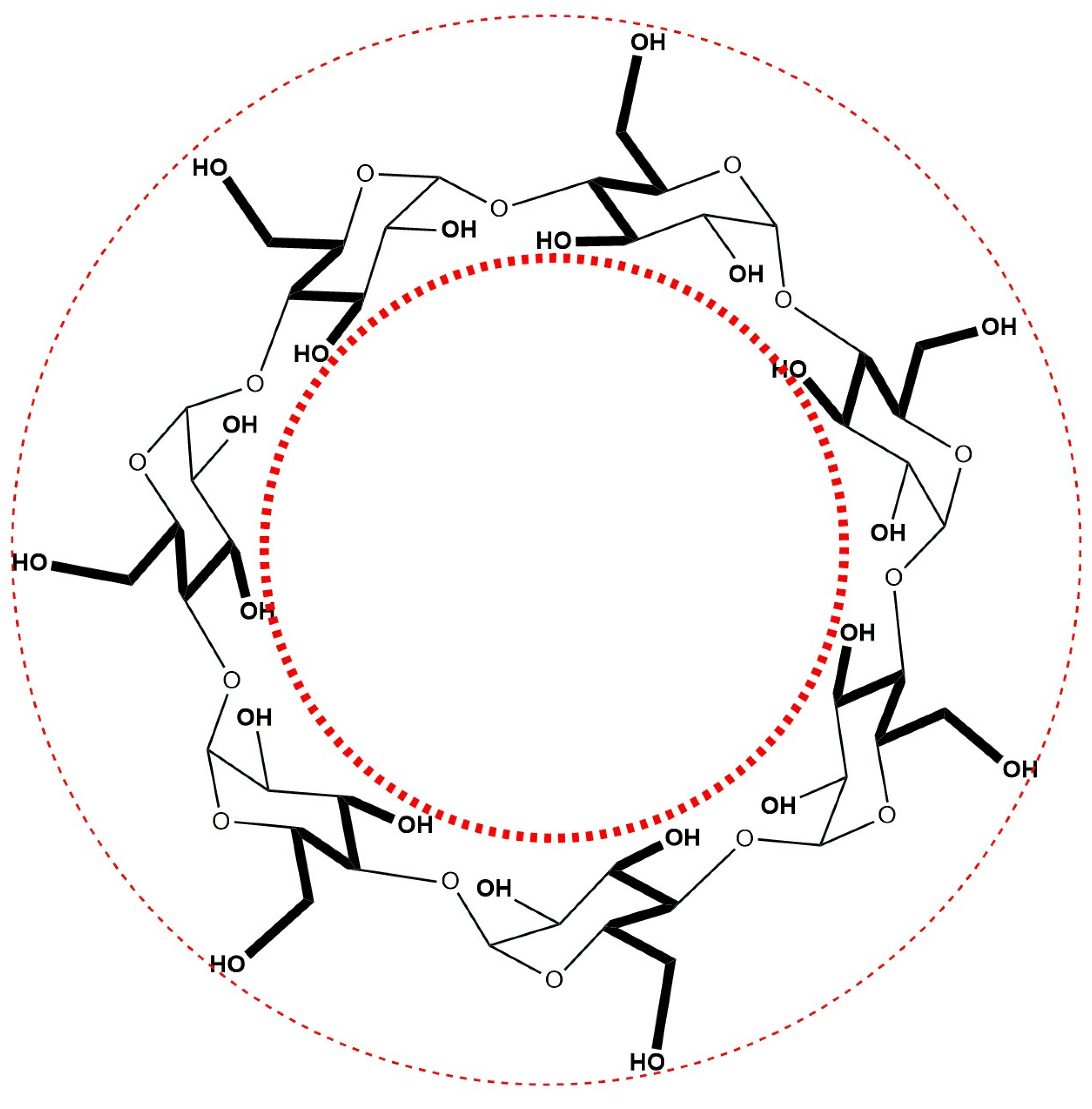

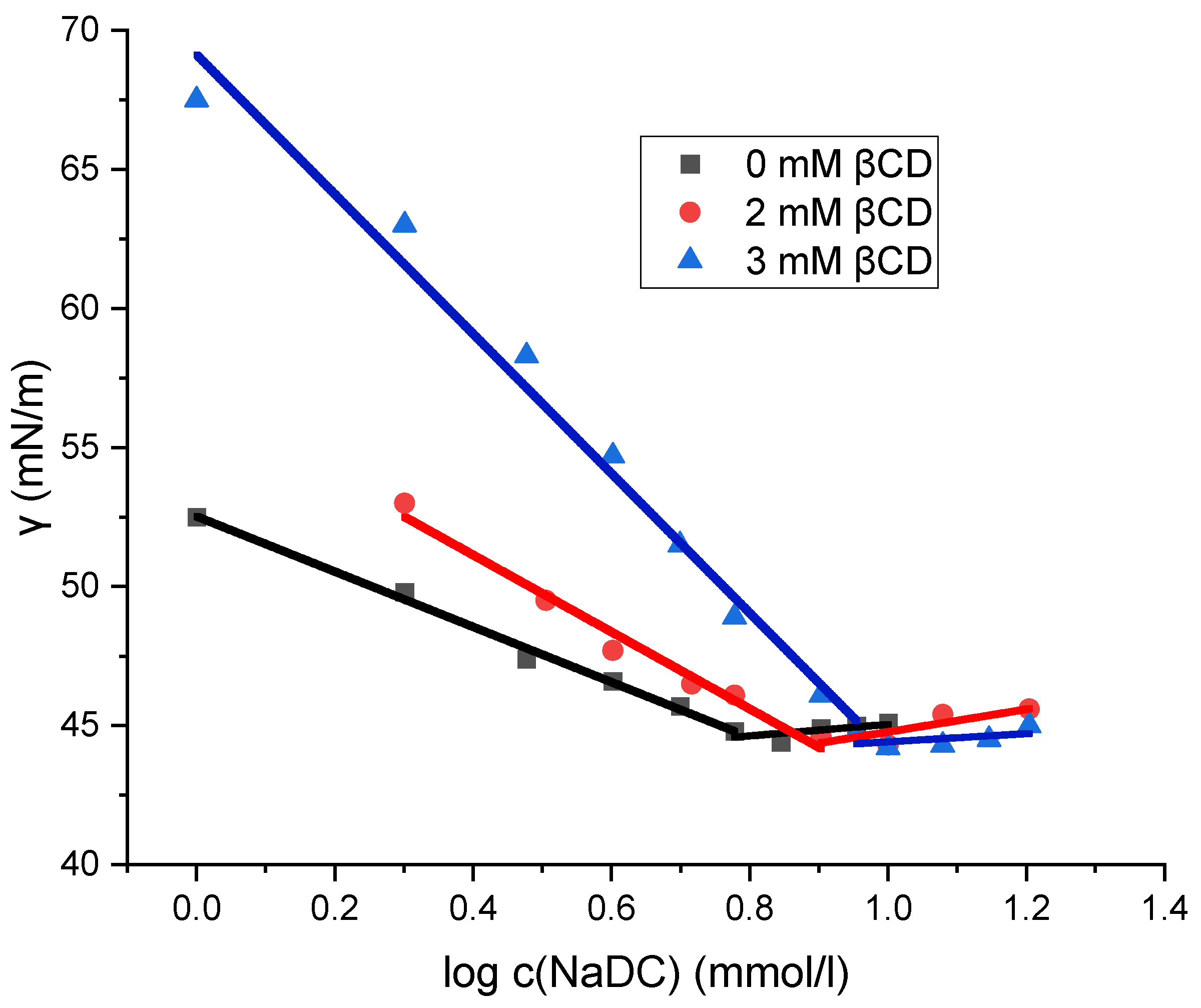
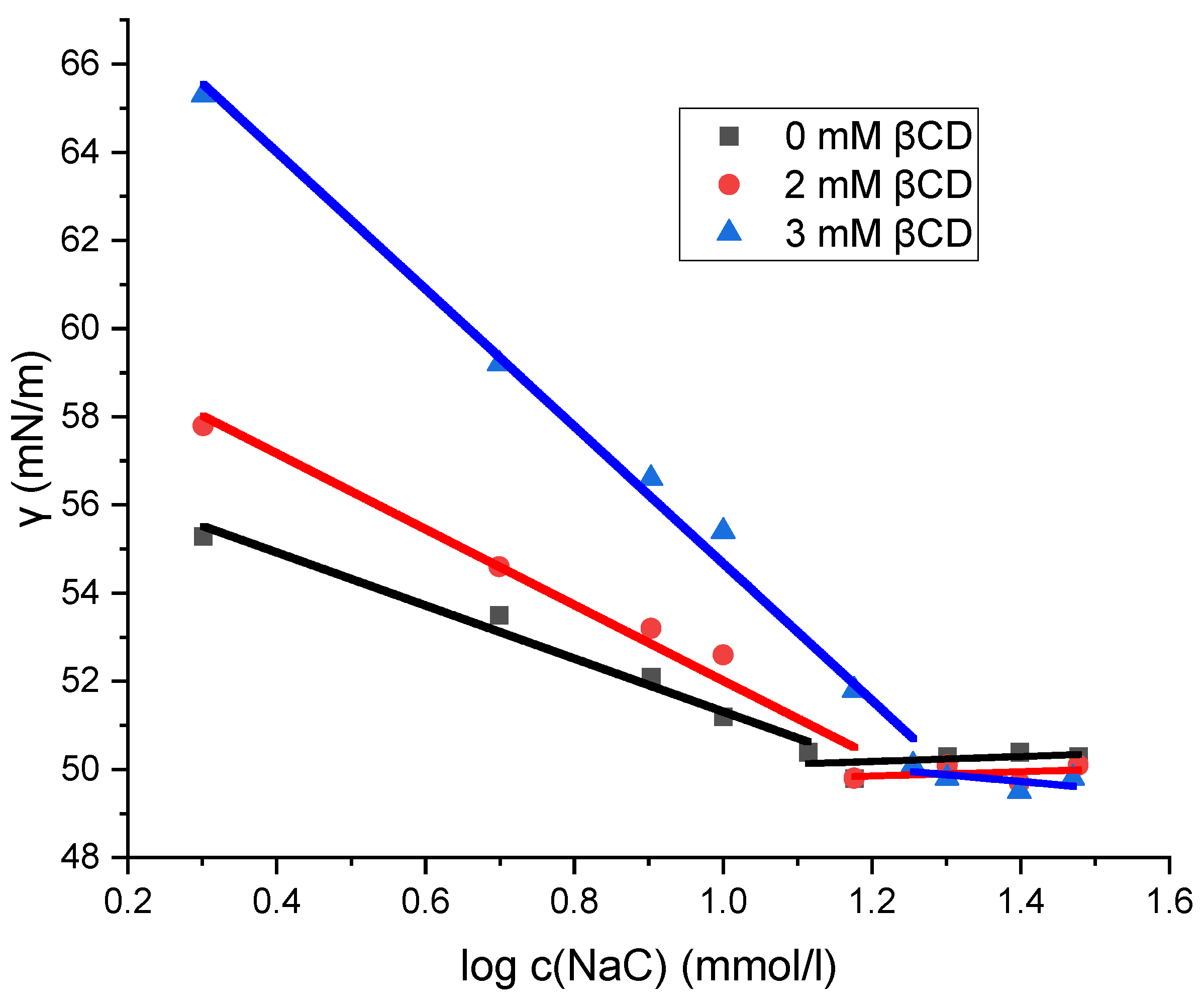
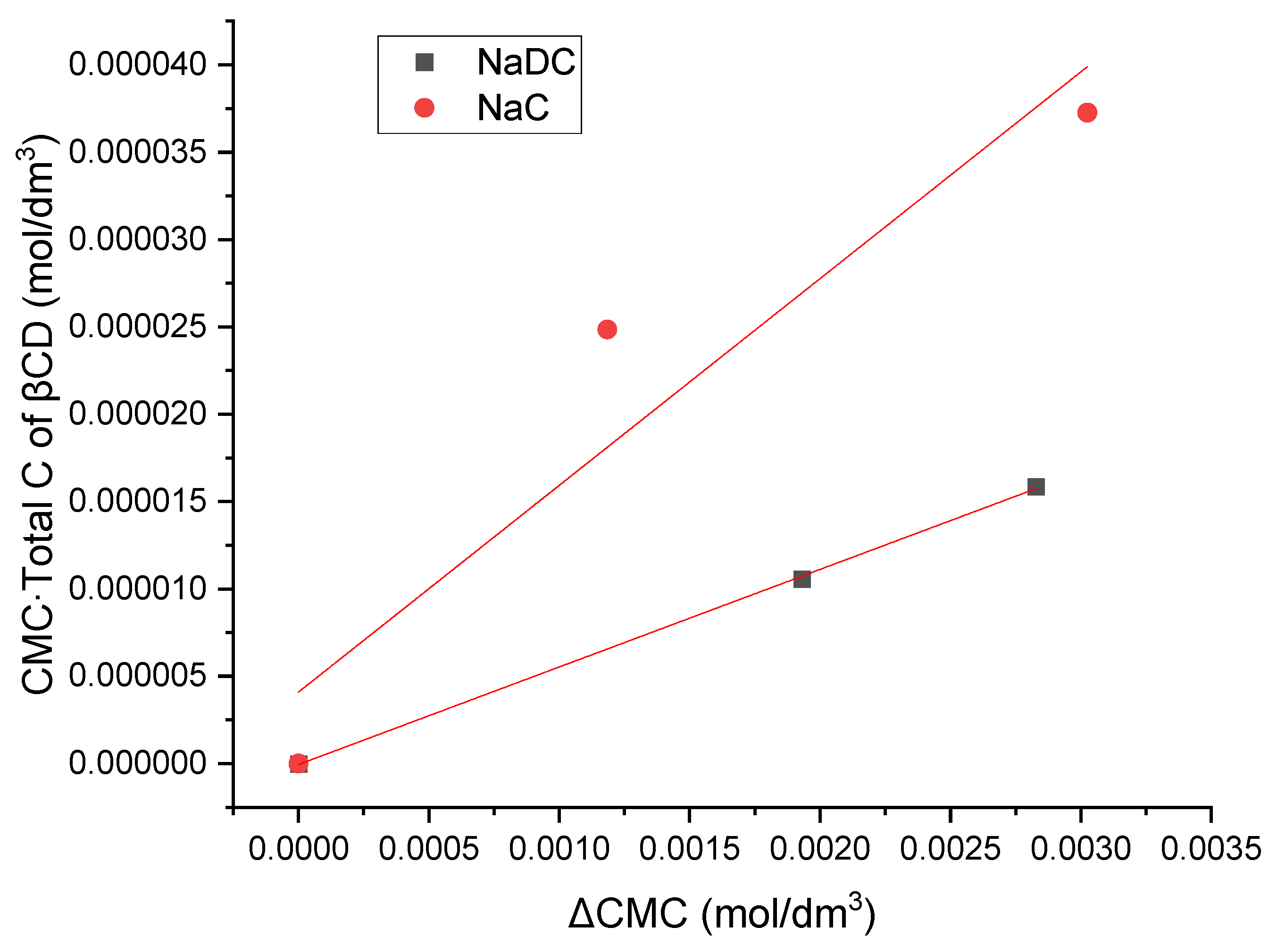

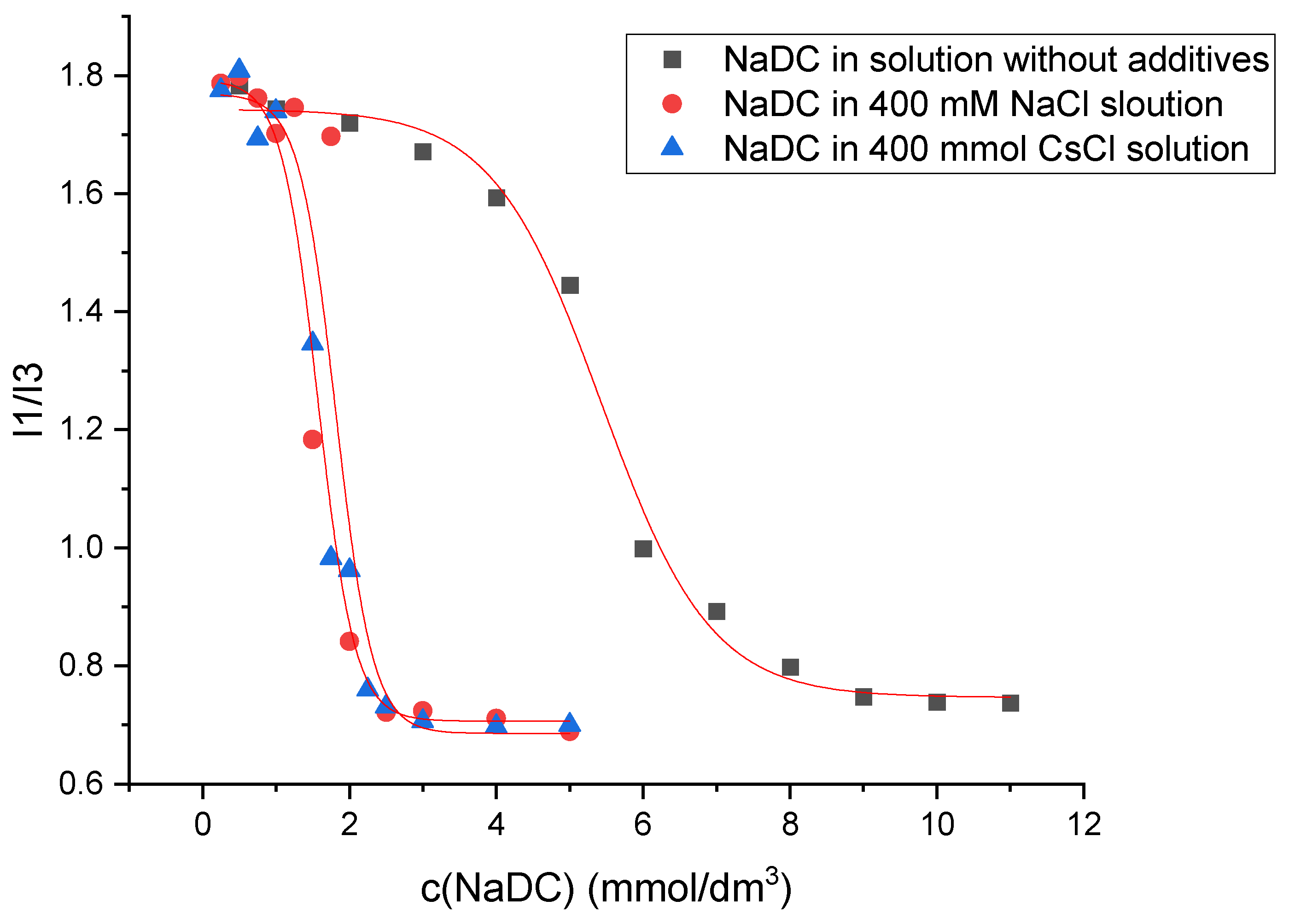
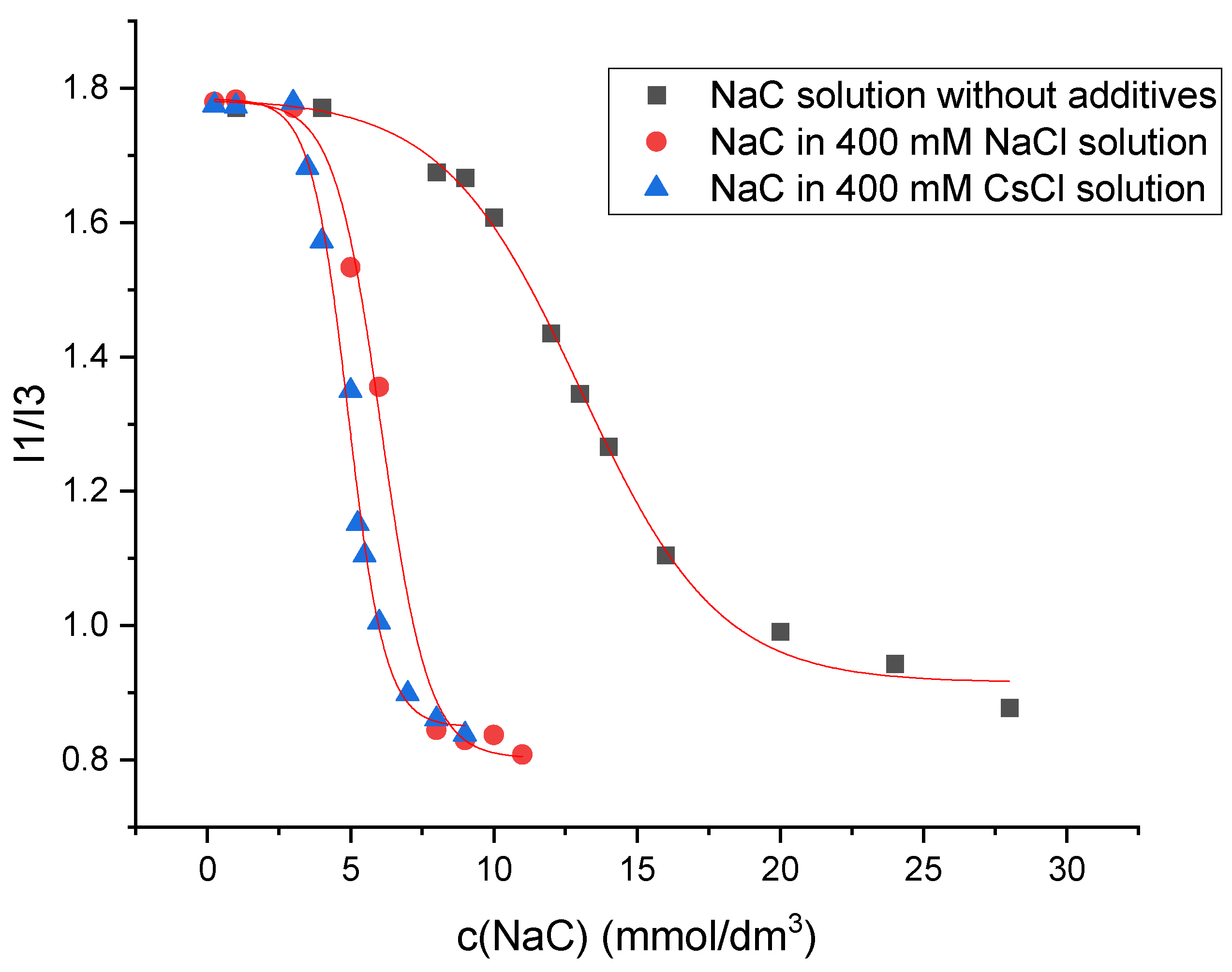
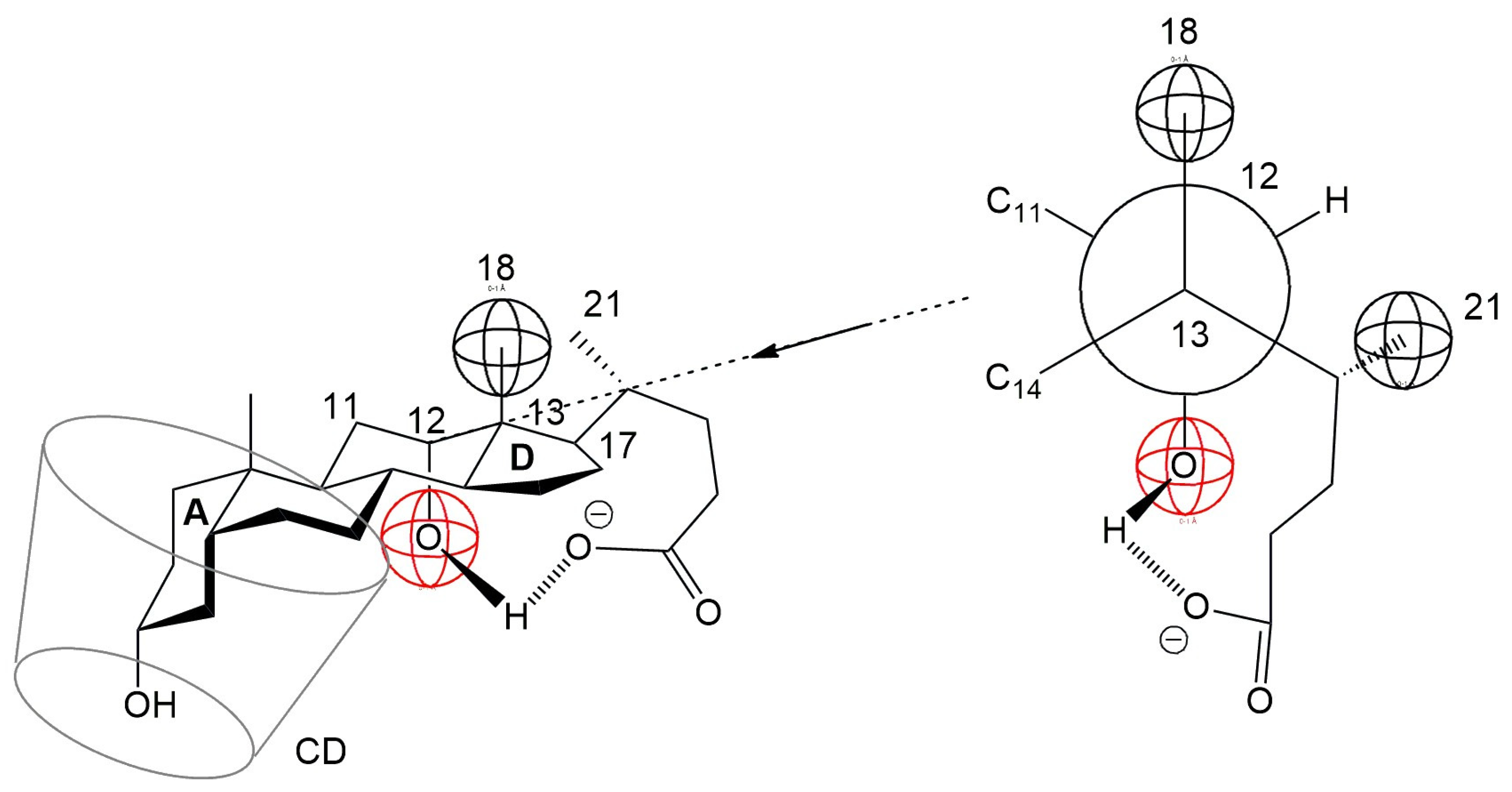
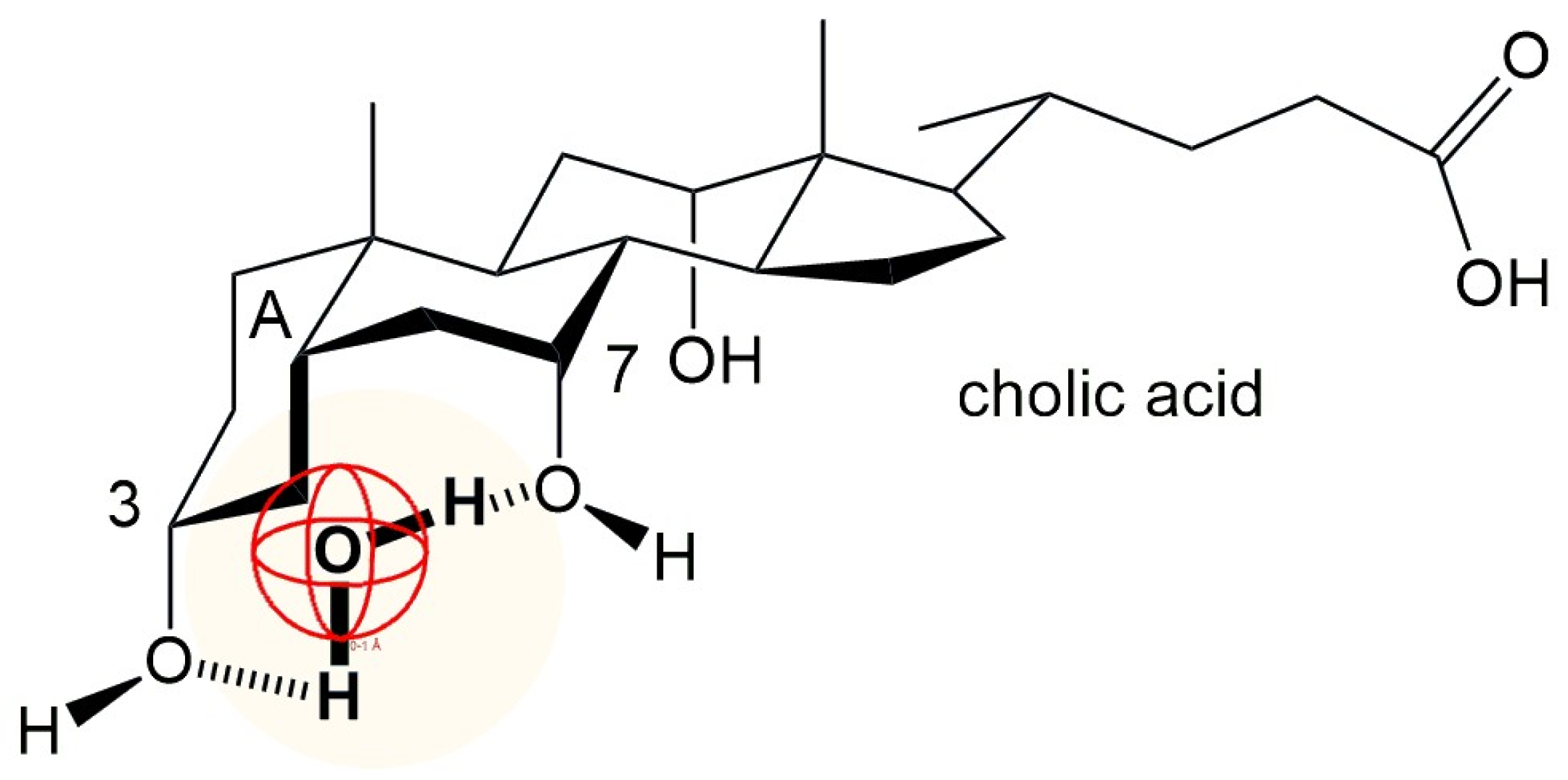
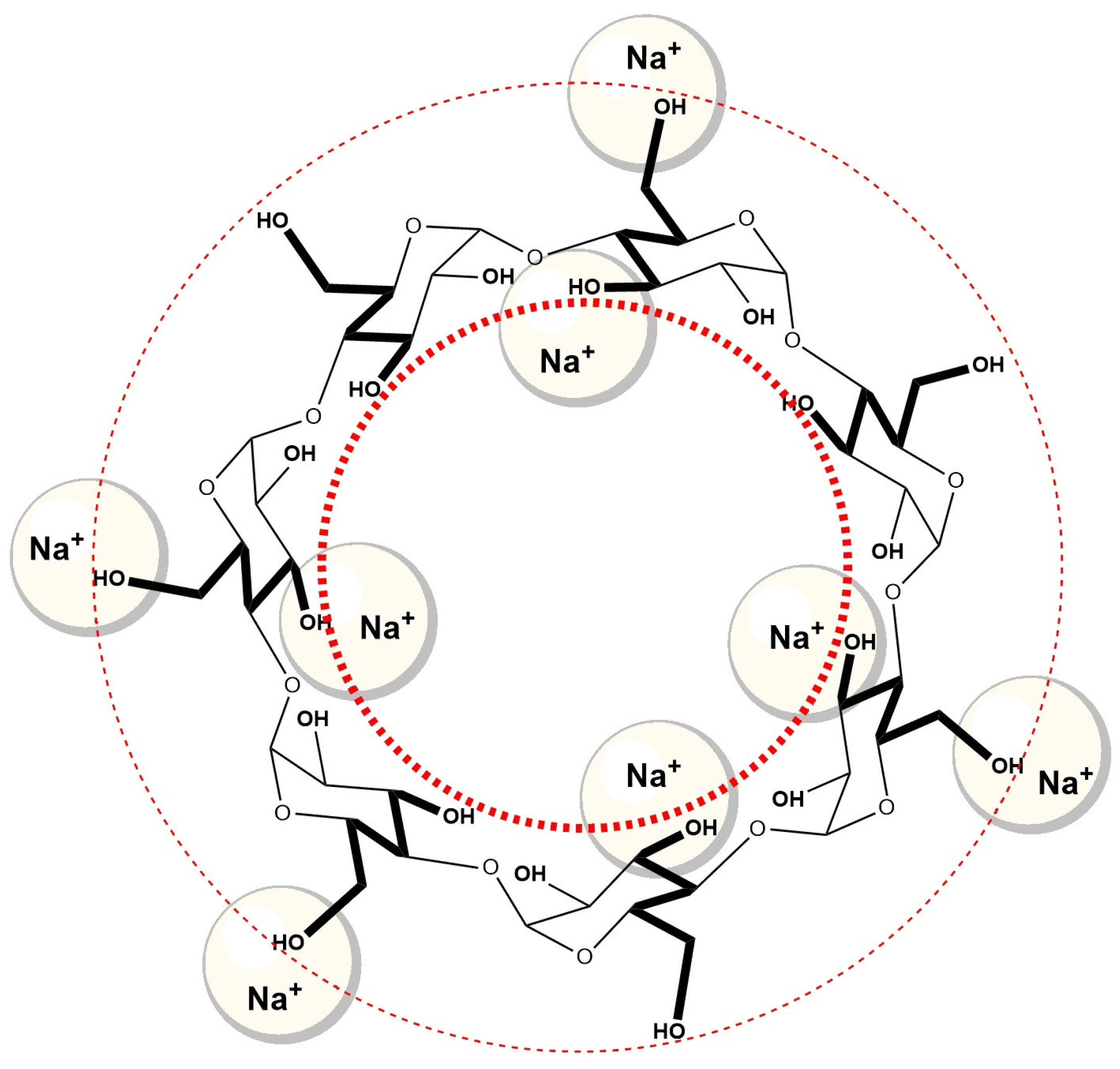
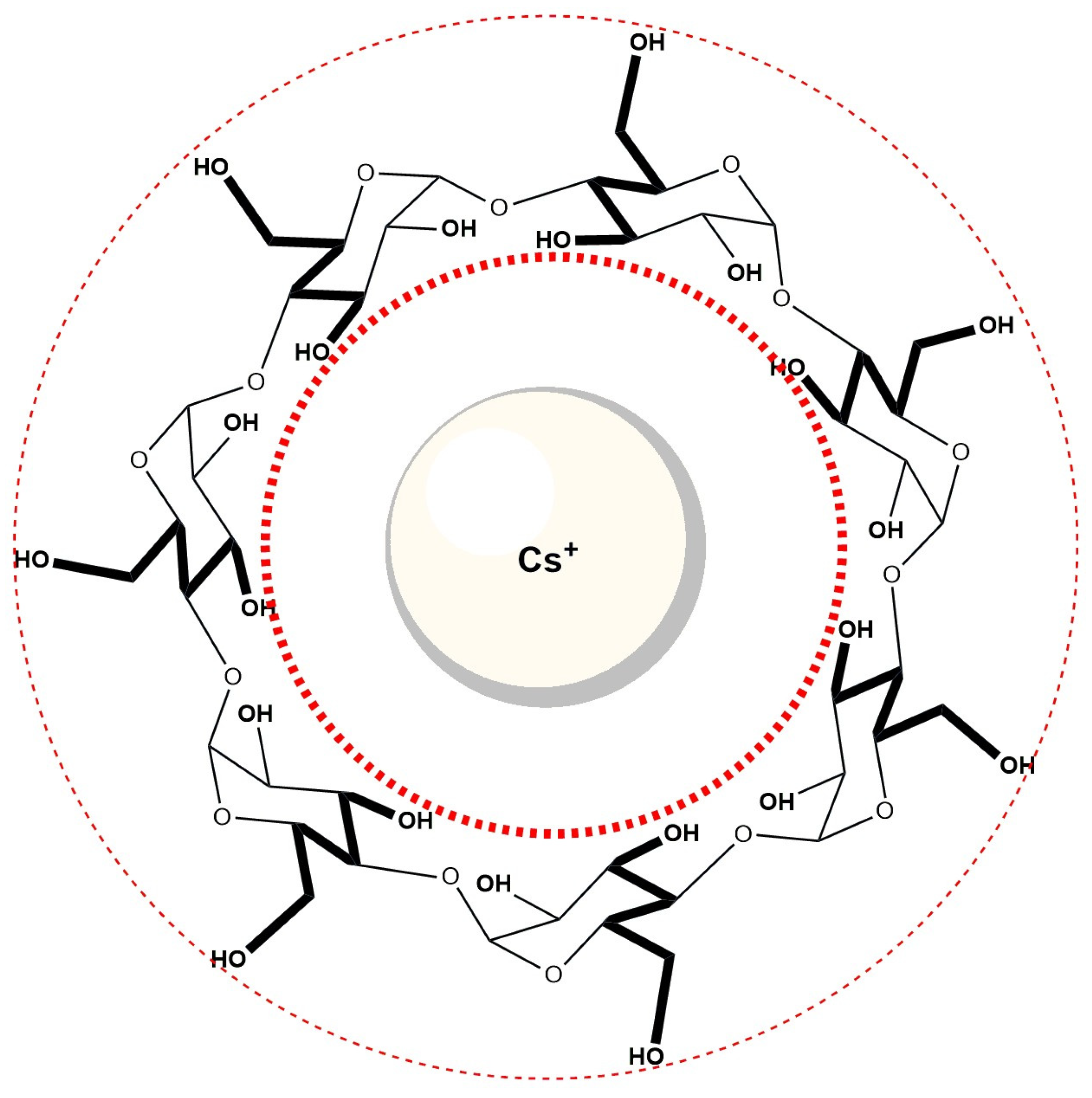
| c(βCD) mM | CMC/mM | |
|---|---|---|
| NaDC | NaC | |
| 0 | 5.2841 ± 0.1585 | 12.4215 ± 0.0186 |
| 2 | 7.2151 ± 0.1804 | 13.6063 ± 0.2041 |
| 3 | 8.1113 ± 0.1622 | 15.5770 ± 0.2336 |
| βCD c/mM | CMC/mM | |||||
|---|---|---|---|---|---|---|
| NaDC in Aqueous Solution | NaDC in 400 mM NaCl Solution | NaDC in 400 mM CsCl Solution | NaC in Aqueous Solution | NaC in 400 mM NaCl Solution | NaC in 400 mM CsCl Solution | |
| 0 | 5.4369 ± 0.2447 | 1.8172 ± 0.0818 | 1.5711 ± 0.0707 | 13.0390 ± 0.3260 | 6.1940 ± 0.1858 | 4.9165 ± 0.1967 |
| 1 | 6.3765 ± 0.2869 | 2.1181 ± 0.0953 | 2.8144 ± 0.1126 | 13.3098 ± 0.3256 | 6.8449 ± 0.2053 | 6.0794 ± 0.2128 |
| 2 | 7.4155 ± 0.29662 | 2.6969 ± 0.0944 | 3.6933 ± 0.1108 | 13.7389 ± 0.3435 | 7.3947 ± 0.2218 | 6.9549 ± 0.2434 |
| 3 | 8.2798 ± 0.2898 | 4.6993 ± 0.1410 | 4.0013 ± 0.1200 | 15.7751 ± 0.3255 | 7.9859 ± 0.1996 | 7.6025 ± 0.2281 |
| 4 | 9.3441 ± 0.2803 | 4.8034 ± 0.1441 | 4.5442 ± 0.1363 | 17.3762 ± 0.3475 | 9.2951 ± 0.2324 | 8.1205 ± 0.2436 |
| 5 | 10.1349 ± 0.3040 | 6.1963 ± 0.1549 | 5.5427 ± 0.2771 | 17.3564 ± 0.3471 | 11.0907 ± 0.2218 | 8.6053 ± 0.2582 |
| (dm3/mol) | |||||
|---|---|---|---|---|---|
| NaDC in Aqueous Solution | NaDC in 400 mM NaCl Solution | NaDC in 400 mM CsCl Solution | NaC in Aqueous Solution | NaC in 400 mM NaCl Solution | NaC in 400 mM CsCl Solution |
| 3703.70 ± 240.74 | 2610.97 ± 156.66 | 3039.51 ± 197.57 | 1040.58 ± 67.64 | 904.16 ± 58.77 | 923.36 ± 60.02 |
Disclaimer/Publisher’s Note: The statements, opinions and data contained in all publications are solely those of the individual author(s) and contributor(s) and not of MDPI and/or the editor(s). MDPI and/or the editor(s) disclaim responsibility for any injury to people or property resulting from any ideas, methods, instructions or products referred to in the content. |
© 2025 by the authors. Licensee MDPI, Basel, Switzerland. This article is an open access article distributed under the terms and conditions of the Creative Commons Attribution (CC BY) license (https://creativecommons.org/licenses/by/4.0/).
Share and Cite
Tepavčević, V.; Farkaš Agatić, Z.; Pilipović, A.; Puača, G.; Poša, M. Effect of β-Cyclodextrin on the Aggregation Behavior of Sodium Deoxycholate and Sodium Cholate in Aqueous Solution. Molecules 2025, 30, 2197. https://doi.org/10.3390/molecules30102197
Tepavčević V, Farkaš Agatić Z, Pilipović A, Puača G, Poša M. Effect of β-Cyclodextrin on the Aggregation Behavior of Sodium Deoxycholate and Sodium Cholate in Aqueous Solution. Molecules. 2025; 30(10):2197. https://doi.org/10.3390/molecules30102197
Chicago/Turabian StyleTepavčević, Vesna, Zita Farkaš Agatić, Ana Pilipović, Gorana Puača, and Mihalj Poša. 2025. "Effect of β-Cyclodextrin on the Aggregation Behavior of Sodium Deoxycholate and Sodium Cholate in Aqueous Solution" Molecules 30, no. 10: 2197. https://doi.org/10.3390/molecules30102197
APA StyleTepavčević, V., Farkaš Agatić, Z., Pilipović, A., Puača, G., & Poša, M. (2025). Effect of β-Cyclodextrin on the Aggregation Behavior of Sodium Deoxycholate and Sodium Cholate in Aqueous Solution. Molecules, 30(10), 2197. https://doi.org/10.3390/molecules30102197






